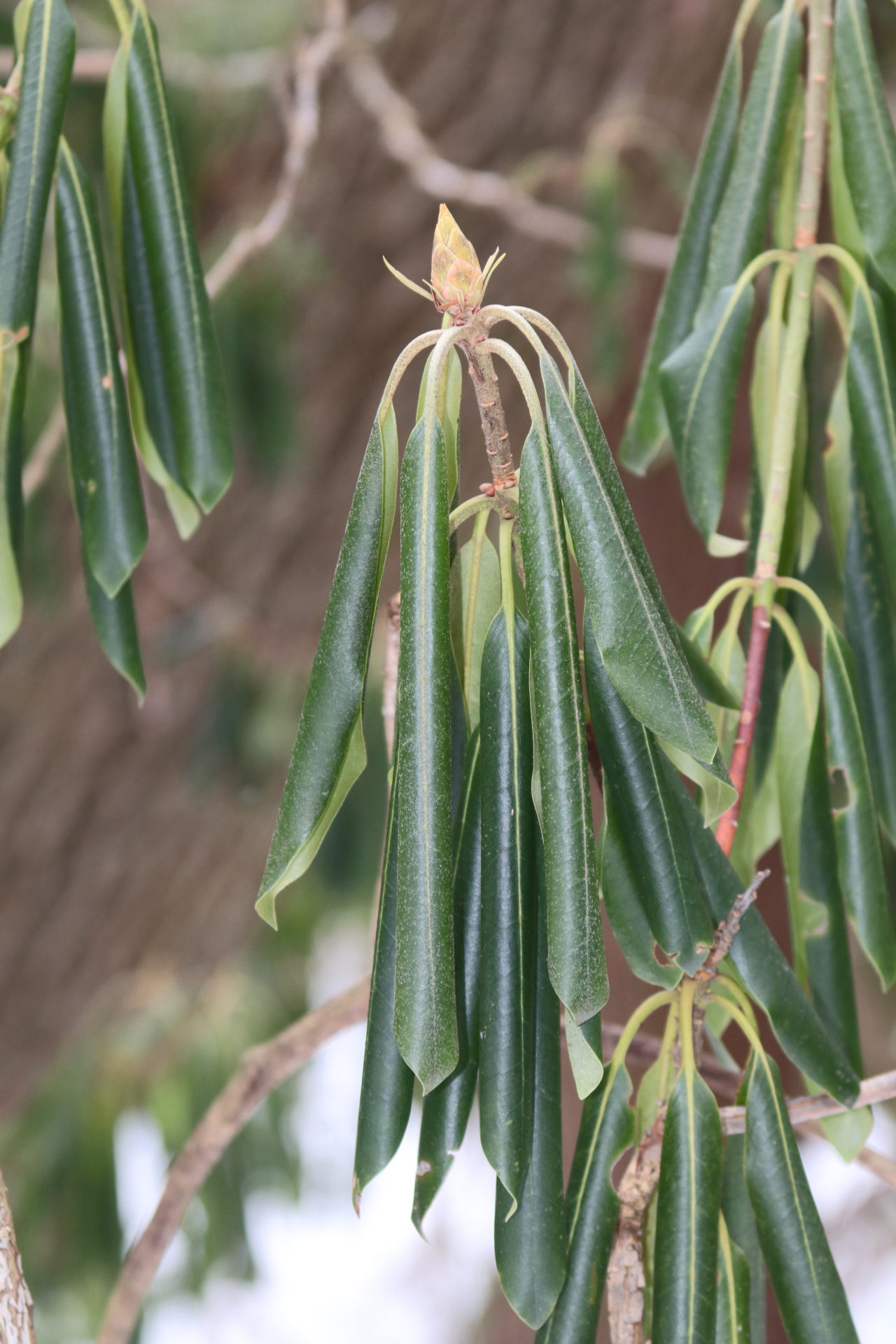
Curled rhododendron leaves indicate single-digit temperatures. The pointed bud is next summer’s flower. Photo by Mark Nale

Curled rhododendron leaves indicate single-digit temperatures. The pointed bud is next summer’s flower. Photo by Mark Nale
Rhododendron leaves hang curled and seemingly lifeless on a frigid winter morning. As temperatures rise into the 20s, rhododendron’s leathery evergreen leaves uncurl to greet the morning sun. When temperatures reach the 30s, their leaves look almost summer-like. This curling-uncurling characteristic makes the rhododendron Mother Nature’s winter thermometer.
Rhododendron is easy to recognize but it is often confused with another flowering evergreen shrub — mountain laurel — the Pennsylvania state flower. Many people refer to rhododendron as laurel, great laurel or buck laurel, which doesn’t help matters.
This confusion dates back to the early Appalachian Mountains explorers, who often referred to rhododendron as laurel. They had very colorful terms (not for family viewing) for the giant patches of rhododendron that blocked their paths and made early map-making efforts difficult. As evidence to the confusion, at least 13 Pennsylvania streams and 22 towns and mountains have laurel in their names.
Two Centre County streams and one in Huntingdon County are called Laurel Run, but not one in the entire state is named Rhododendron Run.
The two plants are in the same family but easy to tell apart. Wild rhododendron, Rhododendron maximum, blooms in late June or early July, while laurel blooms in May or early June. The two blooming times overlap during cold springs. Rhododendron grows much larger and is a stouter plant. It may reach heights of 30 to 40 feet, but most commonly grows to about 15 feet. Mountain laurel is usually shorter, with a large bush growing 10 feet tall. Both plants have shiny evergreen leaves, but rhododendron leaves are much larger, measuring 4-12 inches long.
Rhododendron favors damp narrow hollows and wooded creek bottoms, where it often forms impenetrable thickets many acres in size. Mountain laurel favors drier mountain habitats.
Large, pointed buds during winter foretell early summer’s flowers. Most rhododendron’s white to pink flowers occur profusely one year and are sparse the next. Although shade tolerant, plants getting more sun have more abundant and larger blooms.
The leaves and honey made from the nectar of rhododendron are poisonous to humans, pets and livestock, but deer seem to be immune. If eaten by humans, they can cause mild paralysis, convulsions and cardiac arrhythmia.
According to the literature, rhododendron leaves are a starvation food for white-tailed deer. However, I have seen deer munching on rhododendron leaves during the fall and early winter, and these deer certainly were not starving. Rhododendron thickets provide important cover for deer, bears and other wildlife. Rhododendron even has special pests. A root fungus can kill entire patches, and a moth larva called the rhododendron borer damages stems.
Worldwide, there are more than 900 species in the rhododendron genus, which includes azaleas. Rhododendron is also a popular plant with horticulturists because of its landscaping value and many hybrid crosses have been made. According to the Washington-based Rhododendron Species Foundation, tens of thousands of hybrid rhododendrons exist.
Washington and our neighbor West Virginia have selected rhododendron as their state’s official flower. A wreath of rhododendron leaves and flowers form West Virginia’s state seal. The species that they selected as a state symbol is slightly different from our common rhododendron.
Rhododendron’s strong wood was prized for tool handles during colonial times. When Axis troops cut off the export of briar from northern Africa during World War II, pipe companies returned to a pioneer substitute — wood from rhododendron and mountain laurel.
You can visit a beautiful rhododendron thicket at the Alan Seeger Natural Area in the Rothrock State Forest, southeast of State College.
Mark Nale writes about the outdoors for the Centre County Gazette. This column appears in the Jan. 20-26 edition of the Gazette.
Receive all the latest news and events right to your inbox.

80% of consumers turn to directories with reviews to find a local business.